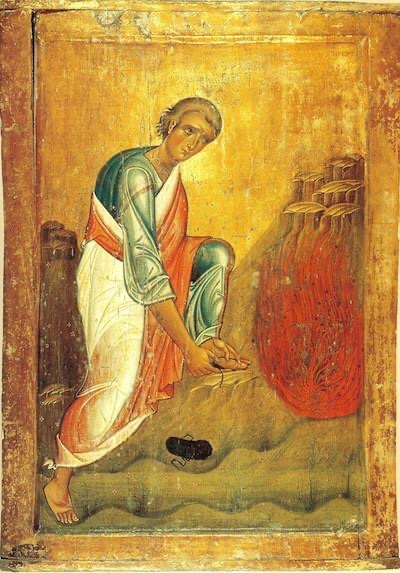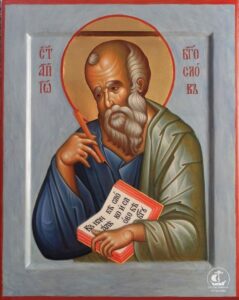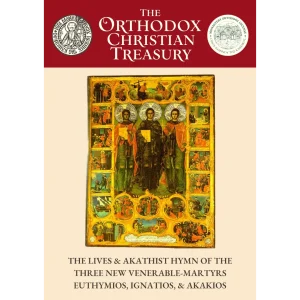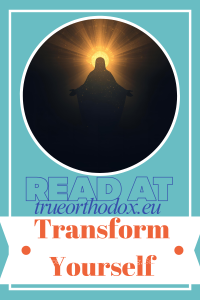THE HOLY GOD-SEER MOSES AND THE THEOLOGY OF ICONS

By Dr. Vladimir Moss
The life of the holy Prophet and God-Seer Moses, whose feast we celebrate today, is so full of extraordinarily significant words and actions that it is difficult to know where to begin. St. Gregory of Nyssa devoted a whole treatise, “The Life of Moses”, to expounding the iconic relationship between the life of Moses and the Life of Christ. In this short article we shall touch only on one small, but important aspect of his life: its teaching on the nature of icons.
Now the Holy Church in her service to Moses makes what at first sight looks like an extraordinary claim: that he was the very first “God-seer”, who saw God face-to-face: “Let Moses, the first among the prophets, be praised, for he was the first to converse openly with God, face to face, not in indistinct images, but beholding Him as in the guise of the flesh.” “Not in indistinct images”, and “in the guise of the flesh”. So he must have had a clear vision of the God-man, the Lord Jesus Christ, in His Humanity. But how was that possible, seeing that Christ was not yet incarnate? The answer is: only by seeing Him in an image, or icon – but one not made with hands.
And yet, one will argue, was it not precisely to Moses that God emphasized the complete invisibility and unknowability of God? And did He not, in His Ten commandments inscribed on tablets of stone for Moses, forbid the making of images and say: “Thou shalt have no other gods beside Me. Thou shalt not make thyself an idol (ειδωλον), nor likeness (ομοιωμα) of anything, whatever things are in the heaven above, and whatever are in the earth beneath, and whatever are in the waters under the earth. Thou shalt not bow down (προσκυνησεις) to them, nor worship (λατρευσεις) them” (Exodus 20:2-5)? True, but Moses did not make any idols, nor did he bow down to or worship anything created. However, he did see an icon of Christ God in the mystical darkness of Mount Sinai… Moreover, in the same place, as St. Gregory of Nyssa writes, “he sees that tabernacle not made with hands, which he shows to those below by means of a material likeness”. So it is not too bold to suggest that it is precisely Moses who lays a beginning to the contemplation of visible icons of God incarnate, and even to the creation of material icons of heavenly things.
But there is more. In this commandment, a distinction is made between veneration (προσκυνησις) and worship (λατρεια) that was to become very important in the iconoclast controversy of the eighth and ninth centuries. Icons are to be venerated, but not worshipped. For an icon of Christ God, though holy and worthy of veneration, is not the same as Christ Himself, although we do truly see Him through the icon.For an icon, according to St. Stephen the Younger, is a “door” into heaven. A door is not part of a room, but it makes possible access to the room. In the same way an icon of Christ is not Christ Himself, but it facilitates our access to Him. Therefore insofar as, in the words of St. Basil the Great, the honour given to an icon is ascribed to its Prototype, when we bow down and venerate an icon of Christ, we are offering honour and worship to Christ Himself.
As Professor Andrew Louth writes in his discussion of St. John of Damascus’ theology of icons: “According to John, we bow down for various reasons: sometimes we bow down to express honour for things or persons (and John gives various biblical examples of this); sometimes, however, we bow down in worship of God. Veneration, bowing down, proskynesis, is one thing; why we do it another. We can bow down to express honour (time), or to express worship (latreia, the word used in Exodus 20.5: ‘you shall not bow down or worship…’). Idolatry is to worship things created, not simply to honour them. This is the heart of John’s defence of the making and veneration of icons…”
In another passage, Moses was told that He could not see God face-to-face, but had to hide behind a cleft in the rock, from behind which He could see, not His face, but only His back parts. Does this contradict what has just been said? No, it clarifies it; for it explains to us that Moses was able to see God face-to-face, not in the sense that He saw His essence, which is unknowable, but in the sense that He recognized Him in His incarnation, in His visible Humanity. “Sheltered by the stone, thou did not see the face of God, for it was hidden, O God-seer, but didst recognize the incarnation of the Word in His back parts.” Or, to be more precise, since Christ was not yet incarnate, Moses saw Him in an icon of His humanity, an icon not made with hands.
The visions of God by the Old Testament Prophets are iconographic visions of the Divine Energies of God, not of His Essence. Thus St. Gregory Palamas, commenting on the Patriarch Jacob’s words: “I have seen God face to face [or person to person], and my soul has been saved”, writes: “Let [the cacodox] hear that Jacob saw the face of God, and not only was his life not taken away, but as he himself says, it was saved, in spite of the fact that God says: ‘None shall see My face and live’. Are there then two Gods, one having His face accessible to the vision of the saints, and the other having His face beyond all vision? Perish the impiety! The face of God which is seen is the Energy and Grace of God condescending to appear to those who are worthy; while the face of God that is never seen, which is beyond all appearance and vision let us call the Nature of God.”
Abraham’s vision at the oak of Mamre was likewise an iconic vision of God, not in His Essence, but in His Energies. Thus St. John Chrysostom writes: “How is it that elsewhere Scripture says, ‘No one will see God and live’ (Exodus 33.20)? How, then, would we interpret the words of Scripture, ‘He appeared’? How did He appear to the just man? Surely he didn’t see His true being? No – God forbid. What, then? He was seen in the way He alone knows and in the manner possible for Abram to see. In His inventiveness, you see, our wise and loving Lord, showing considerateness for our human nature, reveals Himself to those who worthily prepare themselves in advance. He explains this through the sacred author in the words, ‘I gave many visions and took shape in the works of the inspired authors’ (Hosea 12.2). Isaiah in his time saw him seated, something that is inapplicable to God, since He doesn’t sit down – how could He, after all, with His unique nature being incorporeal and indefectible? Daniel too saw Him, as the Ancient of Days. Zechariah had a different vision of Him, and Ezekiel in turn a different one. This is the reason, therefore, that He said, ‘I gave many visions’, that is, I appeared in a way suited to each one.”Since Moses and the other Old Testament Prophets truly saw God in visible form, not in His Essence, but in His Energies, in icons not made with hands, the Seventh Ecumenical Council declares: “Eternal be the memory of those who know and accept and believe the visions of the prophets as the Divinity Himself shaped and impressed them, whatever the chorus of the prophets saw and narrated, and who hold to the written and unwritten tradition of the Apostles which was passed on to the Fathers, and on account of this make icons of the Holy things and honour them.” And again: “Anathema to those who do not accept the visions of the prophets and who reject the iconographies which have been seen by them (O wonder!) even before the Incarnation of the Word, but either speak empty words about having seen the unattainable and unseen Essence, or on the one hand pay heed to those who have seen these appearances of icons, types and forms of the truth, while on the other hand they cannot bear to have icons made of the Word become man and His sufferings on our behalf.” But this is not the last connection of Moses with the New Testament teaching on icons. At the Transfiguration of Christ on Tabor, he was counted worthy to see the Prototype of the image He had seen on Sinai, not in darkness now, but shining in the Divine Light. Not that there was no Light in the first vision: St. Paul says that Moses’ face was shining with Light as he came down from Sinai, but had to “put a veil over his face, so that the children of Israel could not look steadily at the End of what was passing away. But their minds were blinded… Nevertheless, when one turns to the Lord, the veil is taken away” (II Corinthians 3.13-14, 16).
At the Transfiguration the veil was taken away, and the Lord was seen in all His glory. We Orthodox Christians, unlike the Israelites of the Old Testament, do not have a veil over our hearts; we are not blinded that we should not see the Light. As we chant in the Divine Liturgy after receiving Communion: “We have seen the true Light, we have received the Heavenly Spirit.” For having been illumined by the True Faith and Holy Baptism, we are like the Apostles and Prophets on Mount Tabor, Who have His Light dwelling within in us and therefore have seen Christ both in the Uncreated Energies of His Divinity and in the created matter of His Humanity. For “we all, with unveiled face, beholding as in a mirror the glory of the Lord, are being transformed into the same image from glory to glory, just as by the Spirit of the Lord” (II Corinthians 3.18).
And that passage from the veiled to the unveiled vision of God, from images and likenesses not made by hands to the Uncreated Archetype Himself, was indicated to us first of all by the holy Prophet and God-seer Moses, of whom the Church chants: “Even after thy death, thou didst see the Lord, O God-seer, and not in dim images as before thou didst in the rock; but thou didst behold Him as Christ in a human body, illumining all with His Divinity.”
September 4/17, 2016; revised September 4/17, 2020.Holy Prophet and God-seer Moses.






